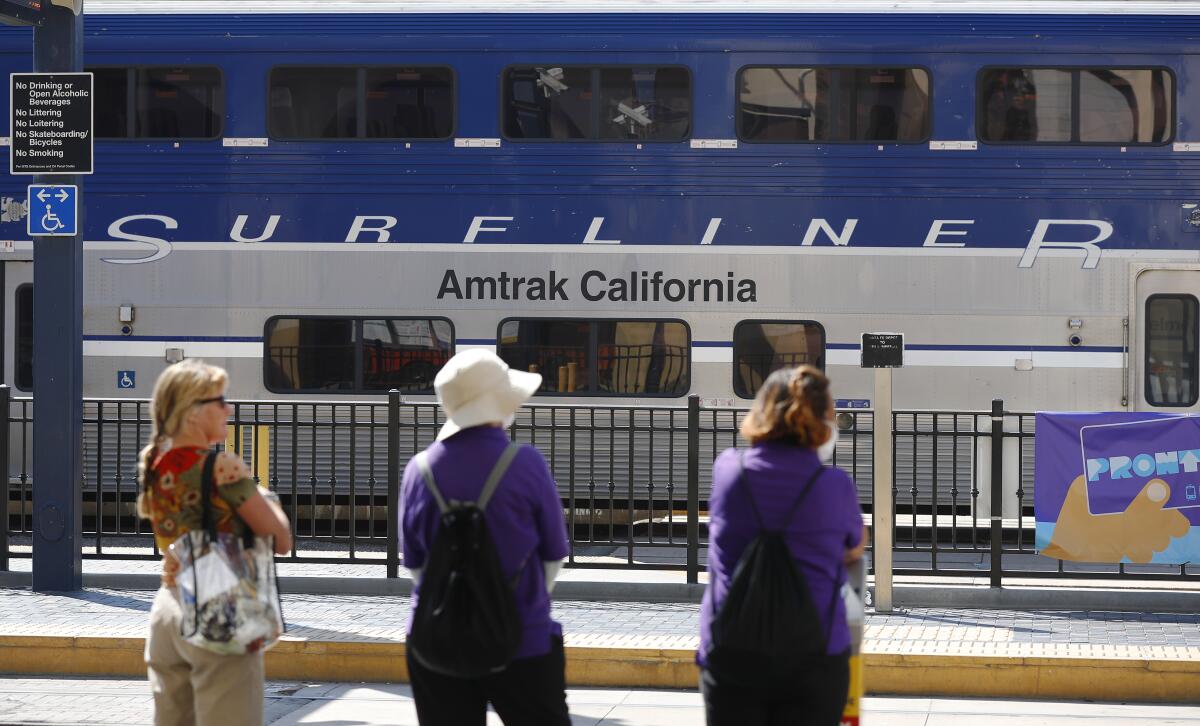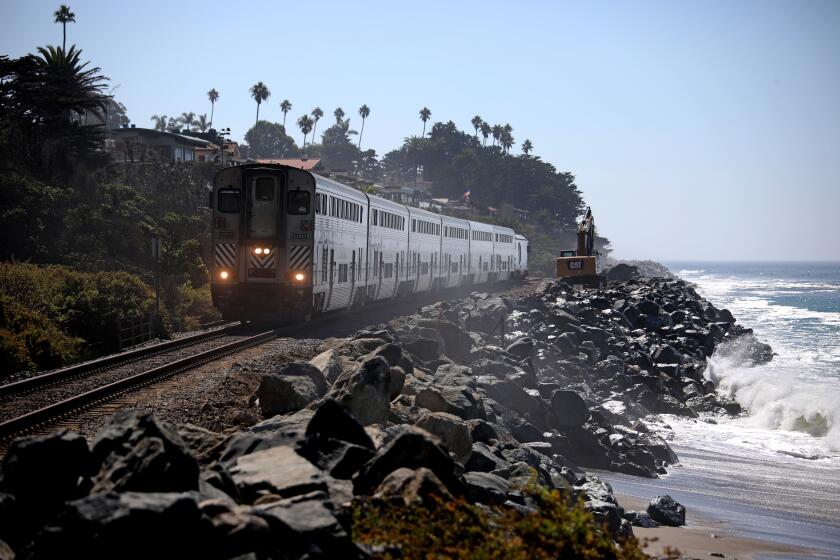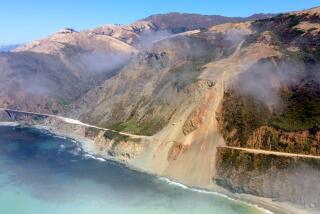New landslide closes railroad tracks at San Clemente, again halting link to San Diego

A new landslide at San Clemente has stopped all rail traffic at a spot two miles north of where the Orange County Transportation Authority recently suspended passenger trains for almost six months and spent more than $13.7 million to stabilize a different slope.
The closure suspends all Metrolink and Amtrak passenger service and BNSF freight service between San Diego and Orange counties. Coaster commuter trains between Oceanside and San Diego are not affected.
It is the latest in a string of rail closures, prompted by a crumbling coastline, that has disrupted commerce and commuter traffic. Passenger rail service was fully restored after the previous landslide less than two weeks ago.
The new trouble spot is below Casa Romantica, a historic property built in the 1920s and now owned by the city of San Clemente and used as a cultural and events center. The city discovered new movement in the slopes there in recent weeks.
The Orange County Transit Authority, in consultation with Metrolink and the LOSSAN Rail Corridor Agency, decided to close the tracks to all passenger and freight service at 1 p.m. Thursday, said transit authority communications manager Joe Zlotnik.
“The debris is falling from above and is getting close to the tracks,” Zlotnik said Thursday afternoon. Though there was no damage to the tracks, the movement was continuing, he said.
No estimate was available for when the tracks would reopen or what may be necessary to safeguard the slope.
Metrolink trains normally go as far south as Oceanside but will not travel south of San Clemente during the closure. During the previous Orange County slope stabilization, Amtrak continued to run trains between Oceanside and San Diego.
The 2.5-acre Casa Romantica was built by San Clemente’s founder on a steep bluff overlooking the railroad tracks. The ground has been moving since cracks were discovered April 16, the Orange County Register reported.
San Clemente City Council members, in an emergency meeting Monday, authorized a $75,000 geological study expected to take about three weeks to evaluate the slope, according to the Register. Devices will be installed to detect and record additional ground movement.

The coastal line is San Diego County’s only railroad link to Los Angeles and other points across the United States. The San Diego-to-Los Angeles-to-San Luis Obispo route traveled by Amtrak’s Pacific Surfliner, known as the LOSSAN corridor, is the second-busiest passenger route in the country, surpassed only by the Northeast Corridor.
The previous landslide farther south occurred below the Cyprus Shore community, forcing a suspension of passenger service for weeks in 2021. OCTA placed tons of boulders on the beach that stopped the slide until new movement was discovered Sept. 30, 2022, launching a more extensive stabilization project and the six-month suspension.
Amtrak service between Goleta and San Luis Obispo was suspended for weeks in January to make storm-related repairs.
Rep. Mike Levin (D-San Juan Capistrano) has twice hosted federal officials to emphasize the need to improve and relocate sections of the tracks that are vulnerable to sea-level rise and coastal erosion.
“It’s just a matter of time, I think we all know, before these tracks will be over the cliff’s edge,” Levin said this month during a visit by Federal Railroad Administration Administrator Amit Bose. “This vital transportation link continues to be a risk.”
Officials with Metrolink are still responding to recent movement detected in the railway’s foundation near San Clemente after Tropical Storm Kay.
Numerous cliff failures have occurred in Del Mar in recent years, where the tracks follow a narrow right-of-way as high as 60 feet above the beach. A series of projects to install vertical columns, seawalls, drainage structures and other devices has been underway there for more than 20 years.
State officials awarded a $300-million grant to the San Diego Assn. of Governments last year for preliminary work needed to move the 1.7 miles of train tracks off the Del Mar bluffs, possibly to an inland tunnel beneath the small city. SANDAG has said construction could be completed by 2035 at a cost of $4 billion or more.
“Just as we have been working with the stakeholders on the planning and relocation here in Del Mar, we also need to do the same thing in Orange County,” Levin said.
OCTA officials said in February they would need $7 million to study possible solutions there, including realignment to protect the seven miles of endangered coastal tracks from Dana Point to the border of San Diego and Orange counties.
The Orange County proposal included $2 million for a first phase of studies to protect the tracks in place with measures such as sand replenishment and retention.
A second phase of studies would require $5 million for a long-term look at potentially relocating the route inland, probably along or underneath Interstate 5. Relocation would require the cooperation of local, regional, state and federal agencies and would cost unknown billions of dollars.
More to Read
Sign up for Essential California
The most important California stories and recommendations in your inbox every morning.
You may occasionally receive promotional content from the Los Angeles Times.











